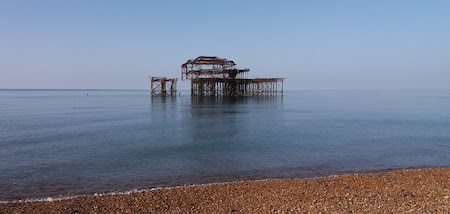
“The Internet of Place” is a great buzzword. When you hear it, you know what it might be, and the concept rhymes well with “Internet of Things”. You imagine small autonomous nodes, taking advantage of their locations in the real world; a blossoming of tiny interactions with the world that makes life more convenient, interesting and meaningful.
In 2015, Brighton was chosen as one of the digital catapult centres, receiving funding and support to set up a variety of technical initiatives, including the Internet of Place. The requirements were open ended, as explained by Nick Hibberd, the head of city regeneration at Brighton & Hove city council: “By allowing a collaborative space, innovation will come. But innovation by its very definition means you don’t know where it’s going to end”. It was intended to provide collaboration between public sector, universities, SMEs, Amex and Gatwick Airport, “to turn Brighton’s best digital ideas from concept into reality, creating new products, services, jobs and value for the local economy”.
The Internet of Place was about combining Internet of Things (IOT) devices with geographical locations. But this vision went beyond the sort of tedious location-based ideas that I’ve seen pushed since the early days of SMS. As the Guardian wrote:
Local leaders also want to use the internet of place to improve the way the city manages its infrastructure, including transport systems, and the 11 million tourists who visit each year. There could be apps to direct drivers away from the most congested areas and help them find free parking spaces. Improving public transport and encouraging visitors to use park and ride facilities
Another important aspect of the catapult was to unlock local data services, with the idea that “data sharing will also help to create better services, from transport to healthcare”. The article explains how data is potentially highly valuable, and exposing it to the world could produce a significant economic boost, with the 5G test network adding to this.
The Internet of Place was also intended to support local business who might not have the technical skills or money to provide a rich digital experience. The Guardian interviewed Ben Potter, from marketing agency Leapfrog, who talked about the IOP driving business to shops without an internet presence: “If we can create a platform that understands the main interests of consumers – such as films, food, clothing brands – then local retailers can send out targeted messages to people’s mobile phones as they walk past,”
(This vision brings with it the danger of location-based spam, one of the big flaws in location based marketing since the early days. How do you engage people while also interrupting them? I’m assuming there are ways to do this, but those challenges probably dwarf the technical ones)
The digital catapult funding has produced two successes in the 5G testbed and am immersive tech lab supporting the production of AR and VR applications. But the promised internet of place applications never appeared.
Searching Google for mentions of the term in the past year returns only a handful of results. It’s a shame, considering how exciting a vision had been laid out a few years before. Given the creativity in Brighton’s tech scene, I can’t imagine what ideas we might have seen around wayfinding, location, retail, , tourism, art and games.